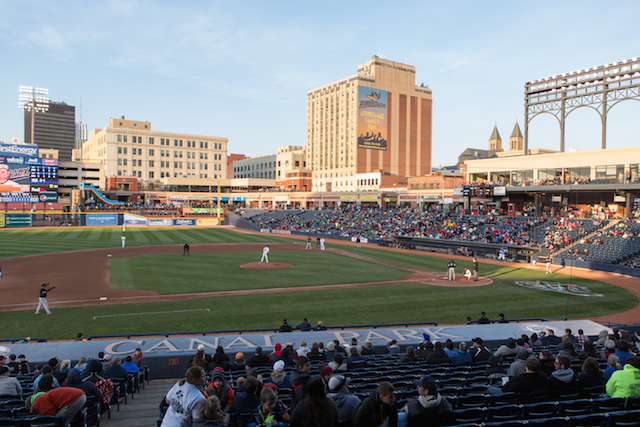By Stacie Zinn Roberts
When the old turf was stripped off of the baseball field late last year to make way for new bluegrass sod at Canal Park, home of the Akron RubberDucks (AA Affiliate team of MLB’s Cleveland Indians) in Akron, OH Chris Walsh was surprised by what he found—high clay content contaminated in the soil profile.
A veteran of five seasons with the RubberDucks as head groundskeeper, Walsh says he’s sure compaction on his field “would have been a lot worse” if he hadn’t taken preventative measures these past 5 years to alleviate and prevent compaction.
“Soils that have a higher clay content are more prone to soil compaction than sandy soils. This is the basis for constructing athletic fields on sand-based soil profiles compared to native soils that contain clay,” says Gerald Henry, PhD,
Associate Professor of Environmental Turfgrass Science, Athletic Association Endowed Professor at the University of Georgia.
“Soil compaction occurs in response to excessive amounts of traffic on athletic field surfaces. The structural integrity of the soil may be compromised, causing a reduction in pore space normally available for water and oxygen,” Henry says.
Compaction may also be caused by an imbalance of soil chemistry, resulting in a decreased soil structure, says Kevin Karnei, geologist with Performance Nutrition, a company that produces fertilizers, fertilizer additives and soil amendments. Karnei explains an imbalance in soil chemistry this way: “Not having enough calcium, magnesium and other ions that would normally keep the clay ‘flocculated’ or spread apart and open so they can receive air, nutrients and water through the pore spaces. A proper balance allows for air and water to move through the soil. An improper balance doesn’t.”
“What you have when you have decreased soil structure is you have collapsed clays that are stacking on top of one another, especially where there’s not good water infiltration, or the soil conditions are not perfect, or the water conditions are sub-standard,” Karnei says.
Compacted soils may cause a myriad of issues on sports fields.
“Compaction causes the soil to lose pliability and the potential to absorb impact. The resulting surface hardness may increase the risk for lower extremity injuries and concussions. Furthermore, surface hardness can greatly reduce field playability, thus impacting aspects of the game such as ball roll, bounce, and speed. Compaction can also reduce root elongation within the soil profile. Athletic fields with shallow root systems have a higher probability of being uprooted during use. This may also increase lower extremity injuries that are associated with traction,” Henry says.
Karnei says signs of sports field compaction include: “decreased water infiltration that results in puddling, shallow roots, decreased vigor and health of the plant, decreased grass health in color, thickness and turgidity, and the ground actually feels harder.”
Chemical and mechanical methods of relieving and preventing soil compaction are available for use on sports fields.
Because Canal Park hosts not just baseball games, but movie nights and other community events, Walsh has a nearly continual parade of foot traffic on his sports field. Since he started at the RubberDucks, Walsh has added KaPre ExAlt to every tank mix he’s sprayed on his field. KaPre ExAlt is a blend of concentrated fulvic acid, polyelectrolytes and naturally derived plant-based surfactants from Performance Nutrition. The product is designed to correct compacted soils by solubilizing minerals in the soil to increase porosity, restore balance in the soil, and increase movement of air and water. It can be applied in a tank mix, or through fertigation.
Walsh says he uses the product to prevent compaction, reduce crusting, but also to help grass seed germination. High traffic areas at short stop, second base and in front of the pitchers mound require frequent applications of overseed. He says using KaPre ExAlt in those areas helps the new grass seed to break through the soil.
Walsh employs mechanical compaction relief, too. Each winter he contacts the front office to reserve a time in the summer when there won’t be a home stand or event, so that he can hire an outside company to do full core aerification of the field. The rest of the year, if he has a one or two-day stretch in between games, or after events, he uses a pull-behind slicer from AerWay to break up the soil without damaging the turf.
In Hawaii on the island of O’ahu, Hawaiian Turfgrass is a company that grows and installs big roll sod for athletic fields and golf courses in the islands. The company also offers mechanical decompaction services to help their sports field customers relieve compaction. Sean Fong, president of Hawaiian Turfgrass, says he and his staff used both the Verti-Quake slicer and Verti-Drain aerification machines, manufactured by Redexim Charterhouse, on the baseball field of Moanalua High School in Honolulu.
“We installed the sod, let it grow in, and used the Verti-Quake and Verti-Drain to relieve compaction on the entire infield,” Fong says. “We saw great results. No more puddling in the infield and good drainage.”
More information about relieving compaction may be on the horizon. Henry and his team at UGA recently began a 2-year research project on sports field compaction. “The first trial is examining spoon aeration timing and frequency over the entire playing season while the other trial is comparing whole-field aeration versus site specific aeration,” Henry says. “Since these trials are still ongoing, we are still in the process of initial data analysis and interpretation.”
Still, relieving compaction may not always need to be so high-tech. Walsh and his crew have been known to take push aerators, even pitch forks and other hand tools out into the field’s compacted areas, to open up the soil. “Anything to loosen the areas up,” Walsh says, “and get some air in there.”


